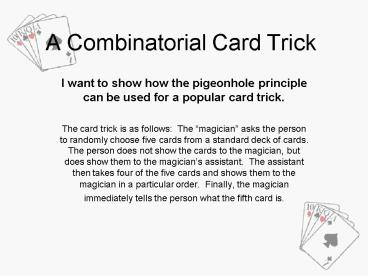A Combinatorial Card Trick - PowerPoint PPT Presentation
1 / 7
Title:
A Combinatorial Card Trick
Description:
The person does not show the cards to the magician, but does show ... and 13 (king) so that 1 follows 13 i.e. the list is ordered in a clockwise direction. ... – PowerPoint PPT presentation
Number of Views:71
Avg rating:3.0/5.0
Title: A Combinatorial Card Trick
1
A Combinatorial Card Trick
- I want to show how the pigeonhole principle can
be used for a popular card trick. - The card trick is as follows The magician
asks the person to randomly choose five cards
from a standard deck of cards. The person does
not show the cards to the magician, but does show
them to the magicians assistant. The assistant
then takes four of the five cards and shows them
to the magician in a particular order. Finally,
the magician immediately tells the person what
the fifth card is.
2
How the trick works
- Using the pigeonhole principle, we must notice
that out of any 5 cards from a deck, at least two
of them are of the same suit. This card is the
first card the assistant shows to the magician.
The suit of this card is also the suit of the
mystery card. So this is how the magician knows
the suit of the card.
3
- Specifying the value of the mystery card can be
accomplished with a little circular counting
manner. We number the cards in a suit circularly
from 1(ace) to 11 (jack), 12 (queen) and 13
(king) so that 1 follows 13 i.e. the list is
ordered in a clockwise direction.
Now, given any two cards A and B, define distance
(A,B) as the clockwise distance from A to B. It
is easy to see that for any two cards A and B
either distance(A,B) or distance(B,A) must always
be less than or equal to 6.
4
- Example
- Cards 3 and Jack (11)
- distance(Jack, 3) 5 distance (3, Jack) 8
- Cards Ace(1) and 7
- distance (Ace, 7) 6
distance (7,Ace) 7
5
- From those two cards of the same suit, A and B,
the accomplice shows the magician card A such
that distance(A, B) is 6 or less. - For example, given the choice between the three
of clubs and the Jack of clubs, the accomplice
reveals the Jack (since distance (Jack ,3) 5
and distance(3, Jack) 8). The three of clubs
remains hidden. - If the two same-suit cards are the five of
hearts and the six of hearts, the accomplice
chooses the five (since distance (5,6) 1 but
distance (6,5) 12) leaving the six of hearts
as the mystery card. - Finally, the accomplice arranges the last three
cards to encode a number from 1 to 6 the
distance from the value of first card to that of
the hidden card. A quick calculation allows the
magician to discover the value of the mystery
card. Notice that although the magician must
decode only one of 6 possibilities, it should not
present a problem, even to the slowest of
magicians.
6
- We must assign each card a number from 1 to 52
for ranking purpose. For example, - the ace of spade can be numbered 1 (the
highest ranking card), - ace of heart numbered 2,
- ace of club numbered 3,
- ace of diamond numbered 4,
- king of spade numbered 5,
- queen of spade numbered 9, jack of
spade numbered 13, - 10 of spade numbered 17,
- 2 of diamond numbered 52 (the
lowest ranking card)
7
- Consider the following example
The assistant notices that the 3 and the 7 have
the same suit -- hearts. Since the distance( 3
,7) 4 and distance(7, 3) 9, the accomplice
chooses the 3 as the first card to show the
magician, leaving the 7 of hearts as the hidden
card. The magician now knows that the suit of the
mystery card is hearts. The accomplice's next
task is thus to let the magician know that he
must add the value 4 to the number 3 to obtain
the final value of 7 for the hidden card!































